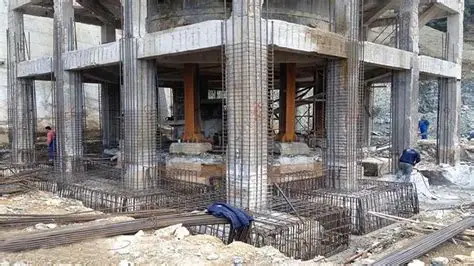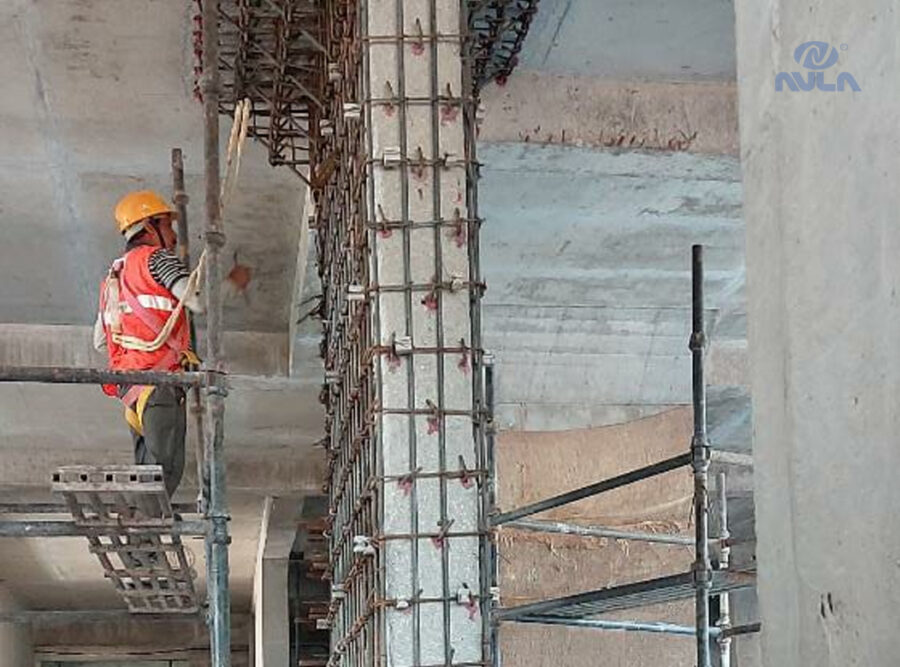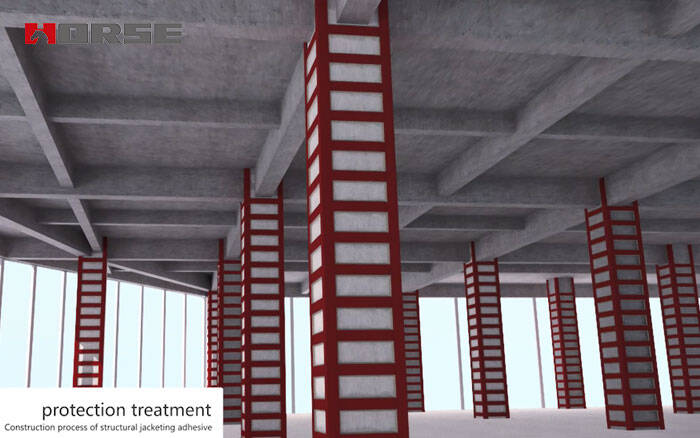Column jacketing improves structural performance in several key-ways. It restores or increases axial load capacity, enhances shear resistance, and improves confinement.

Columns remain the backbone of most structural systems. They carry vertical loads and transfer forces safely to the foundation. When columns fail or show weakness, the safety of the entire structure comes into question. The failure of a beam could portend failure to a single floor. However, the failure of a column could result in absolute collapse of a structure. For this reason, engineers place strong emphasis on ensuring that columns remain reliable throughout the lifespan of a building.
Sometimes, however, columns may no longer perform as intended. Concrete may deteriorate through corrosion of reinforcement. Steel may lose section due to rust or repeated loading. Masonry may crack under settlement or seismic forces. In addition, buildings often face new loading requirements as use changes. Columns, therefore, may require strengthening or repair to meet current design demands.
Column jacketing offers a practical solution to these challenges. Jacketing involves adding material around an existing column to increase strength, ductility, and durability. Engineers adopt various jacketing methods depending on structural material, failure mode, and site conditions. Among the most common techniques are reinforced concrete jacketing, steel jacketing, and fibre-reinforced polymer (FRP) jacketing. Each method comes with unique advantages, detailing requirements, and performance characteristics.
The Role of Column Jacketing in Structural Engineering
Column jacketing improves structural performance in several key ways. It restores or increases axial load capacity, enhances shear resistance, and improves confinement. These effects reduce the likelihood of brittle failures during earthquakes or under unexpected loads. Jacketing also compensates for deficiencies in original design or poor detailing of reinforcement.
Engineers use jacketing both as a repair technique and as a preventive strengthening measure. In seismic retrofitting, jacketing ensures that columns develop ductile behaviour rather than brittle shear failures. In buildings facing increased load demands, jacketing provides cost-effective capacity upgrades compared to full replacement. The versatility of the technique explains its widespread adoption across different structural systems.
For effective jacketing, engineers consider material compatibility, constructability, and long-term durability. Proper detailing ensures that the jacketed column behaves as a composite unit, transferring stresses smoothly between the original section and the added material. Poor workmanship or inadequate bond can reduce the effectiveness of jacketing and introduce new vulnerabilities.
Reinforced Concrete Jacketing
Reinforced concrete jacketing remains one of the most traditional and widely applied methods (Figure 1). It involves enlarging the cross-section of the existing column by adding new reinforcement and encasing it with fresh concrete.

This method increases both axial and flexural strength. The additional reinforcement and larger section improve load-carrying capacity, while the surrounding concrete enhances confinement. Engineers prefer concrete jacketing for severely deteriorated columns or those requiring significant capacity enhancement.
Execution begins with surface preparation of the existing column. Engineers roughen or scarify the old surface to promote mechanical bond. In many cases, bonding agents improve adhesion between old and new concrete. Steel reinforcement is then fixed around the column, anchored into the foundation and tied to existing reinforcement where possible. Finally, concrete is cast around the assembly, usually with high-strength material to maximise improvement.
Concrete jacketing proves particularly effective for columns in seismic regions. By increasing confinement, the method improves ductility, allowing the column to undergo larger deformations without collapse. This prevents brittle shear failures and promotes desirable flexural behaviour. However, the technique increases member dimensions, which may interfere with architectural layouts or reduce usable space. It also requires significant construction time, formwork, and curing, making it less suitable where rapid intervention is necessary.
Steel Jacketing
Steel jacketing provides a faster and often less bulky alternative to concrete jacketing (Figure 2). Engineers wrap steel plates or sections around existing columns to provide confinement and increase load capacity.

The method typically uses steel plates welded or bolted to form a casing around the column. For circular columns, rolled steel shells can be installed. Once fixed, the jacket acts as an external reinforcement system, confining the core and resisting both axial and lateral loads. Engineers may grout the space between the steel jacket and the column to ensure uniform load transfer.
Steel jacketing excels in scenarios demanding rapid strengthening. It requires less wet work compared to concrete jacketing, allowing quicker execution. In addition, steel provides high strength with relatively small thickness, making it suitable for projects with architectural or space constraints.
Engineers often adopt steel jacketing for seismic retrofits. The confinement provided by the jacket significantly improves ductility and energy dissipation during earthquakes. It also increases shear strength, reducing vulnerability to brittle failure modes. However, steel jacketing introduces challenges related to corrosion protection and fire resistance. Engineers must apply protective coatings or encase the jacket to prevent degradation over time. Welding quality also requires close supervision to avoid introducing fatigue-prone details.
Fibre-Reinforced Polymer (FRP) Jacketing
Fibre-reinforced polymer jacketing represents a modern alternative to traditional methods. FRP consists of high-strength fibres such as carbon, glass, or aramid embedded in a polymer matrix (Figure 3). Engineers apply FRP sheets or wraps externally to columns, bonding them with adhesives to form a thin but strong confining layer.

The major advantage of FRP jacketing lies in its lightweight nature and high strength-to-weight ratio. It imposes minimal additional load while significantly improving column performance. FRP wraps enhance both axial and shear capacity, while confinement increases ductility. The material also resists corrosion, making it suitable for aggressive environments where steel or concrete jackets may deteriorate.
Installation involves surface preparation of the column, adhesive application, and wrapping of FRP sheets. Engineers orient fibres strategically depending on required performance, often placing them circumferentially to maximise confinement. Multiple layers may be applied to achieve the desired strength.
FRP jacketing finds widespread use in seismic retrofitting. The material provides excellent confinement, delaying crushing of concrete and improving energy absorption. Engineers also use FRP for emergency strengthening because of its rapid installation and minimal disruption to building use. Limitations include higher material costs and sensitivity of polymers to fire and high temperatures. Adhesive performance under long-term moisture and thermal cycles also requires careful consideration.
Comparing the Methods
While concrete, steel, and FRP jacketing all aim to improve column strength, their applications differ. Concrete jacketing remains best for severely deteriorated columns and projects requiring significant capacity enhancement. It offers durability and cost-effectiveness but increases dimensions.
Steel jacketing provides rapid and compact strengthening. It suits projects with limited space or tight timelines but requires careful corrosion and fire protection. Its high strength makes it suitable for seismic upgrades, though detailing demands careful attention.
FRP jacketing stands out for its ease of installation and excellent confinement with minimal added weight. It proves ideal for emergency retrofits, seismic improvements, or environments where corrosion poses challenges. However, high cost and vulnerability to fire limit its use in some projects.
Many times, engineers select the method based on structural needs, site constraints, budget, and expected performance. In some projects, hybrid approaches combine techniques for optimal results. For example, engineers may use concrete jacketing for load enhancement while applying FRP for additional ductility.
Practical Considerations in Design and Execution
Effective jacketing begins with detailed structural assessment. Engineers evaluate existing condition, failure modes, and required improvements. Non-destructive testing, material sampling, and load analysis guide the decision on suitable jacketing technique.
During execution, attention to detail proves critical. Bond between existing and new materials determines composite action. Inadequate surface preparation or poor workmanship can lead to premature debonding. Construction must also address load transfer during jacketing, often requiring temporary shoring or load redistribution.
Durability considerations extend beyond immediate strengthening. Engineers design for fire resistance, corrosion protection, and environmental exposure. For FRP, this may involve protective coatings against ultraviolet light. For steel, protective paint or encasement ensures longevity. Concrete jackets may require high-quality mixes with low permeability.
Cost remains another practical factor. While concrete jacketing often proves cheapest in material terms, it requires longer construction time. Steel and FRP jackets may reduce time-related costs despite higher material expenses. Engineers weigh both direct and indirect costs to select the most efficient approach.
Jacketing in Seismic Retrofitting
Seismic retrofitting provides one of the strongest motivations for column jacketing. Earthquakes subject columns to combined axial, shear, and flexural demands. Inadequate detailing in older structures often leads to brittle shear failure or poor confinement.
Jacketing methods address these vulnerabilities by enhancing ductility, confinement, and shear resistance. Concrete jacketing increases section size and reinforcement, creating ductile flexural hinges rather than brittle shear cracks. Steel jacketing confines concrete core and provides additional energy dissipation. FRP jacketing delays crushing and improves cyclic performance.
Engineers assess expected seismic demands and select jacketing methods that best provide ductile behaviour. The goal remains to prevent sudden collapse and allow structures to withstand multiple loading cycles. Proper detailing ensures that retrofitted columns act integrally with beams and slabs to form continuous load paths.
Applications of Column Jacketing
Concrete jacketing finds use in aging public buildings where columns must carry greater loads due to change of occupancy. Many seismic rehabilitation projects in South Asia and South America adopt this method extensively.
Steel jacketing appears frequently in bridge retrofits. It provides quick strengthening without disrupting traffic for long durations. Industrial facilities also benefit from the speed and compactness of steel jacketing solutions.
FRP jacketing continues to gain popularity in heritage buildings. Its minimal thickness preserves architectural features while providing significant strengthening. Emergency retrofits in earthquake-prone regions also favour FRP because of its rapid application and low added weight.
Conclusion
Column jacketing remains one of the most reliable methods for strengthening and retrofitting structural systems. Whether applied through concrete, steel, or FRP, the technique addresses deficiencies and extends structural life. Each method carries distinct benefits and challenges, requiring engineers to carefully match solution to problem.
Also See: Strengthening of Existing Buildings – A Background Across Structural Types
Sources & Citations
- Park, R., & Paulay, T. (1975). Reinforced Concrete Structures. Wiley, New York.
- Fardis, M. N. (2009). Seismic Design, Assessment and Retrofitting of Concrete Buildings. Springer, Dordrecht.
- Teng, J. G., Chen, J. F., Smith, S. T., & Lam, L. (2002). FRP-Strengthened RC Structures. Wiley, Chichester.
- American Concrete Institute (ACI). (2017). Guide for Strengthening Concrete Structures (ACI 562-16). ACI, Farmington Hills, MI.
👍👍